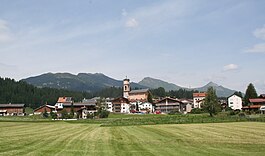
Summary
Lantsch/Lenz (German: 'Lenz', Romansh: Lantsch) is a municipality in the Albula Region in the canton of Graubünden in Switzerland.
Lantsch/Lenz | |
|---|---|
 Lantsch/Lenz | |
 Flag  Coat of arms | |
Location of Lantsch/Lenz .mw-parser-output .locmap .od{position:absolute}.mw-parser-output .locmap .id{position:absolute;line-height:0}.mw-parser-output .locmap .l0{font-size:0;position:absolute}.mw-parser-output .locmap .pv{line-height:110%;position:absolute;text-align:center}.mw-parser-output .locmap .pl{line-height:110%;position:absolute;top:-0.75em;text-align:right}.mw-parser-output .locmap .pr{line-height:110%;position:absolute;top:-0.75em;text-align:left}.mw-parser-output .locmap .pv>div{display:inline;padding:1px}.mw-parser-output .locmap .pl>div{display:inline;padding:1px;float:right}.mw-parser-output .locmap .pr>div{display:inline;padding:1px;float:left}html.skin-theme-clientpref-night .mw-parser-output .od,html.skin-theme-clientpref-night .mw-parser-output .od .pv>div,html.skin-theme-clientpref-night .mw-parser-output .od .pl>div,html.skin-theme-clientpref-night .mw-parser-output .od .pr>div{background:#000;color:#fff}html.skin-theme-clientpref-night .mw-parser-output .locmap{filter:grayscale(0.6)}@media(prefers-color-scheme:dark){html.skin-theme-clientpref-os .mw-parser-output .locmap{filter:grayscale(0.6)}html.skin-theme-clientpref-os .mw-parser-output .od,html.skin-theme-clientpref-os .mw-parser-output .od .pv>div,html.skin-theme-clientpref-os .mw-parser-output .od .pl>div,html.skin-theme-clientpref-os .mw-parser-output .od .pr>div{background:#000;color:#fff}}  Lantsch/Lenz  Lantsch/Lenz | |
| Coordinates: 46°41′N 9°34′E / 46.683°N 9.567°E | |
| Country | Switzerland |
| Canton | Graubünden |
| District | Albula |
| Area | |
| • Total | 21.81 km2 (8.42 sq mi) |
| Elevation | 1,328 m (4,357 ft) |
| Population (31 December 2018)[2] | |
| • Total | 533 |
| • Density | 24/km2 (63/sq mi) |
| Time zone | UTC+01:00 (Central European Time) |
| • Summer (DST) | UTC+02:00 (Central European Summer Time) |
| Postal code(s) | 7083 |
| SFOS number | 3513 |
| ISO 3166 code | CH-GR |
| Surrounded by | Alvaneu, Alvaschein, Arosa, Brienz/Brinzauls, Vaz/Obervaz |
| Website | www SFSO statistics |
The majority of its population is German-speaking, with a significant Romansh-speaking minority.
History edit
Lantsch/Lenz is first mentioned around 850 as Lanzes.[3]
Geography edit
Lantsch/Lenz has an area, as of 2006[update], of 21.8 km2 (8.4 sq mi). Of this area, 27% is used for agricultural purposes, while 34.4% is forested. Of the rest of the land, 3.8% is settled (buildings or roads) and the remainder (34.8%) is non-productive (rivers, glaciers or mountains).[4]
Until 2017, the municipality was located in the Belfort sub-district of the Albula district, after 2017 it was part of the Albula Region.[5] It is located at an elevation of 1,294 m (4,245 ft) on a terrace above the right side of the Albula river. It consists of the linear village of Lantsch/Lenz. Until 1943 Lantsch/Lenz was known as Lenz.[6]
Demographics edit
Lantsch/Lenz has a population (as of 31 December 2020) of 560.[7] As of 2008[update], 12.5% of the population was made up of foreign nationals. Over the last 10 years the population has grown at a rate of 1.5%. Most of the population (as of 2000[update]) speaks German (54.2%), with Romansh being second most common (36.7%) and Albanian being third ( 2.5%).[4]
As of 2000[update], the gender distribution of the population was 51.6% male and 48.4% female.[8] The age distribution, as of 2000[update], in Lantsch/Lenz is; 49 people or 10.1% of the population are between 0 and 9 years old. 32 people or 6.6% are 10 to 14, and 29 people or 6.0% are 15 to 19. Of the adult population, 36 people or 7.4% of the population are between 20 and 29 years old. 76 people or 15.7% are 30 to 39, 66 people or 13.6% are 40 to 49, and 61 people or 12.6% are 50 to 59. The senior population distribution is 56 people or 11.5% of the population are between 60 and 69 years old, 61 people or 12.6% are 70 to 79, there are 16 people or 3.3% who are 80 to 89, and there are 3 people or 0.6% who are 90 to 99.[9]
In the 2007 federal election the most popular party was the CVP which received 38.9% of the vote. The next three most popular parties were the SVP (33.2%), the SPS (16.2%) and the FDP (10.8%).[4]
The entire Swiss population is generally well educated. In Lantsch/Lenz about 73.7% of the population (between age 25-64) have completed either non-mandatory upper secondary education or additional higher education (either university or a Fachhochschule).[4]
Lantsch/Lenz has an unemployment rate of 2.24%. As of 2005[update], there were 24 people employed in the primary economic sector and about 9 businesses involved in this sector. 25 people are employed in the secondary sector and there are 5 businesses in this sector. 83 people are employed in the tertiary sector, with 31 businesses in this sector.[4]
The historical population is given in the following table:[3][8]
| year | population |
|---|---|
| 1710 | 215 |
| 1850 | 353 |
| 1900 | 363 |
| 1950 | 355 |
| 1960 | 366 |
| 1970 | 373 |
| 1980 | 382 |
| 1990 | 453 |
| 2000 | 485 |
Heritage sites of national significance edit
St. Mary's Church in Lantsch/Lenz is listed as a Swiss heritage sites of national significance.[10]
References edit
- ^ a b "Arealstatistik Standard - Gemeinden nach 4 Hauptbereichen". Federal Statistical Office. Retrieved 13 January 2019.
- ^ "Ständige Wohnbevölkerung nach Staatsangehörigkeitskategorie Geschlecht und Gemeinde; Provisorische Jahresergebnisse; 2018". Federal Statistical Office. 9 April 2019. Retrieved 11 April 2019.
- ^ a b Lantsch/Lenz in German, French and Italian in the online Historical Dictionary of Switzerland.
- ^ a b c d e Swiss Federal Statistical Office Archived 2016-01-05 at the Wayback Machine accessed 24-Sep-2009
- ^ Swiss Federal Statistical Office - Amtliches Gemeindeverzeichnis der Schweiz - Mutationsmeldungen 2016 accessed 16 February 2017
- ^ Amtliches Gemeindeverzeichnis der Schweiz published by the Swiss Federal Statistical Office (in German) accessed 23 September 2009
- ^ "Ständige und nichtständige Wohnbevölkerung nach institutionellen Gliederungen, Geburtsort und Staatsangehörigkeit". bfs.admin.ch (in German). Swiss Federal Statistical Office - STAT-TAB. 31 December 2020. Retrieved 21 September 2021.
- ^ a b Graubunden in Numbers Archived 2009-09-24 at the Wayback Machine (in German) accessed 21 September 2009
- ^ Graubunden Population Statistics Archived 2009-08-27 at the Wayback Machine (in German) accessed 21 September 2009
- ^ Swiss inventory of cultural property of national and regional significance Archived 2009-05-01 at the Wayback Machine 21.11.2008 version, (in German) accessed 24-Sep-2009
External links edit
- Media related to Lantsch/Lenz at Wikimedia Commons
- Official website (in German)
- Lantsch/Lenz in German, French and Italian in the online Historical Dictionary of Switzerland.


